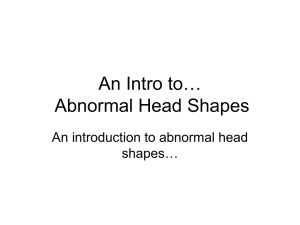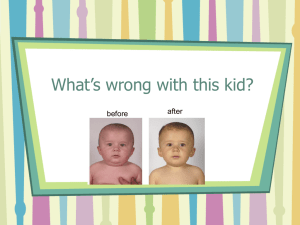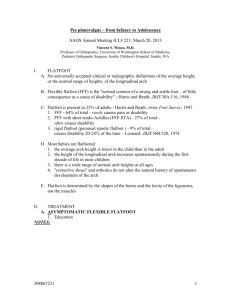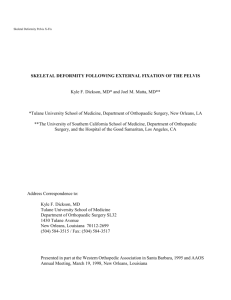Funny Shaped Heads - Peyton Manning Children`s Hospital
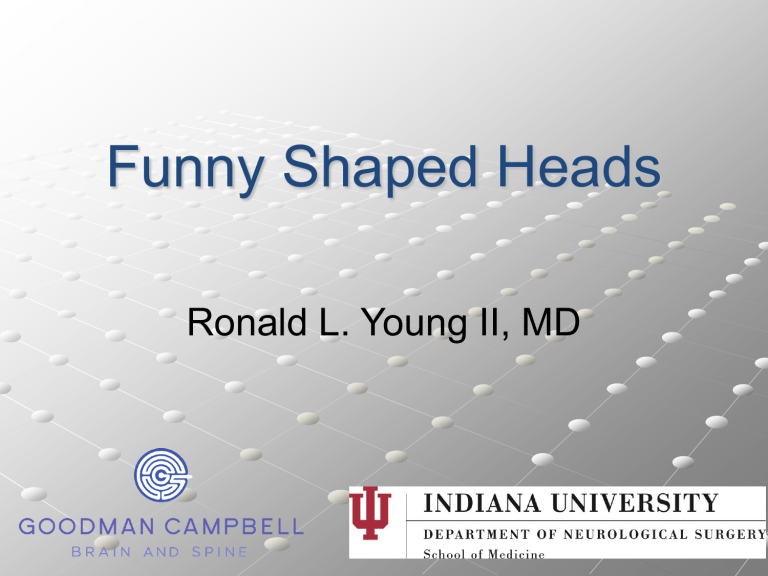
Funny Shaped Heads
Ronald L. Young II, MD
Funny shaped heads
Etiologies
Congenital deformities
Positional molding
Cephalohematomas
Mass lesions
Molded Heads
Plagiocephaly
Brachycephaly
Scaphocephaly
Positional Plagiocephaly
Occipital flattening
Anterior displacement ear
Bulge forehead
Bulge malar eminence
Parallelogram
Local bald spot
Positional Plagiocephaly
Associated with “ torticollis ”
Short sternocleidomastoid on flat side
Not stretched out
Decreased rotation away from flat side
Uterine constraint
Positional brachycephaly
Symmetric flat occiput
Increased bi-parietal diameter
No ridging
Focal bald spot
Severe cases have ears pointing down
Positional brachycephaly
Deep sleepers
Don ’ t move after falling asleep
Don ’ t sleep in bed
Infant seat
Bouncy seat
Hypotonia
Cause not effect
Positional Scaphocephaly
“ Premie head ”
Common in severe premies
Can evolve into craniostenosis
VP Shunt
Pathology
Soft skull
Weight of brain able to flatten skull
Rapidly growing skull
Self sustaining
Flat tire
Time Course
Flat spot noticeable 1 m/o
Deformity peaks 4 m/o (Corrected)
Head control
Primary deformity
Flat spot
Secondary deformity
Compensatory bulge
Time Course
Improvement of the flat spot 6 m/o
Posterior bulge
Dent in inion 6 m/o
Bulge takes 12-16 months 2 y/o
Brain molds from inside
Time Course
Ear asymmetry 3 y/o
Not cosmetic problem
Rare residual deformity
Why So Long? Head Growth
Treatment
Position Therapy
Keep off the flat spot
Sleep
<4 m/o Wedges and blankets
Roll on side
>4 m/o Fetal position
Let baby fall asleep in usual position
Then rotate onto side in fetal position
Start at naps
Treatment
Position Therapy
Sit up in swing
Get out of bouncy seat and infant seat
Exer-saucer
Walker
“ Tummy Time ”
Treatment
Molding Helmet
Act like dental braces
Slowly push in secondary deformity
Keep off the primary deformity
Treatment
Molding Helmet
Patients with helmets look better faster
Need to be worn to work
Shoot for 23 hours / day
Need to be custom fit
Earlier the better
Won ’ t work as well after 12 mo
Treatment
Molding Helmet
Cost
Cranialtech $3000
Advanced Orthopro
Complications
Compliance
Skin breakdown
$1400
Treatment
Molding Helmet
My indications
Borderline parents
Can ’ t get concept of keeping off flat spot
Hypotonic children
Won ’ t have head control by 4 months
Hydrocephalus post shunt
Will not have brain growth to mold skull
Significant facial bulge
Just not getting better
Craniosynostosis
What is it?
Premature fusion of the cranial sutures
Sutures allow progressive enlargement of the skull with brain growth
Normal sutural fusion is complete at 6 to 8 years of age
Premature fusion produces progressive skull deformity
Epidemiology
Occurs in 1 in 2100 children
Primary non-syndromic is most common
Lambdoid synostosis is very rare
Multiple sutures involved in 8% of nonsyndromic cases
Calvarial Development
Intramembranous ossification
Margins of calvarial bones form osteogenic front
Sutures form at sites of near contact
New bone is laid down by osteoblasts in spicules at the sutural margins
Overall bone growth is driven by the expanding brain
Calvarial Development
Pathobiology
Known causes of craniosynostosis
Teratogens
Metabolic disorders
Rickets
Valproic acid, aminopterin, retinoic acid
Hyerthyroidism
Malformation Mucopolysaccharido ses
Hurler ’ s, Morquio ’ s
Hematologic disorders
Thalassemias, sickle cell anemia, polycythemia vera
Microcephaly
Encephalocele shunted hydrocephalus holoprosencephaly
Pathobiology
Syndromic
Crouzon
Apert ’ s
Pfeiffer
Jackson-Weiss
Pathobiology
<10% inherited or syndromic
90% spontaneous
Uterine constraint
Early drop into cervical canal
Multiple births
Severe back pain last month of pregnancy
Pathobiology
Premature closure of calvarial sutures also affects the skull base
Coronal and metopic
Effect extends to nasoethmoid complex, orbital roofs, and supraorbital ridges
Diagnosis
Characteristic skull shape
Lack of movement at suture
Palpable ridging of fused suture
CT scan
Fusion, sclerosis, skull base deformities
Metopic
Metopic
Unicoronal
Bicoronal
Sagittal
Lamdoid
Cloverleaf deformity
The case for surgery
Aesthetic and functional
Elevated ICP in 14% of single and 47% of children with multiple sutural synostosis
Uncorrected children often socially isolated and stigmatized
Low risk with modern craniofacial surgery
Surgery
Surgery
Complications
Blood loss
Infection
CSF leak
Post surgical trauma
Poor cosmetic result
Persistent cranial defects
Results
Results
Results
Thank You!
